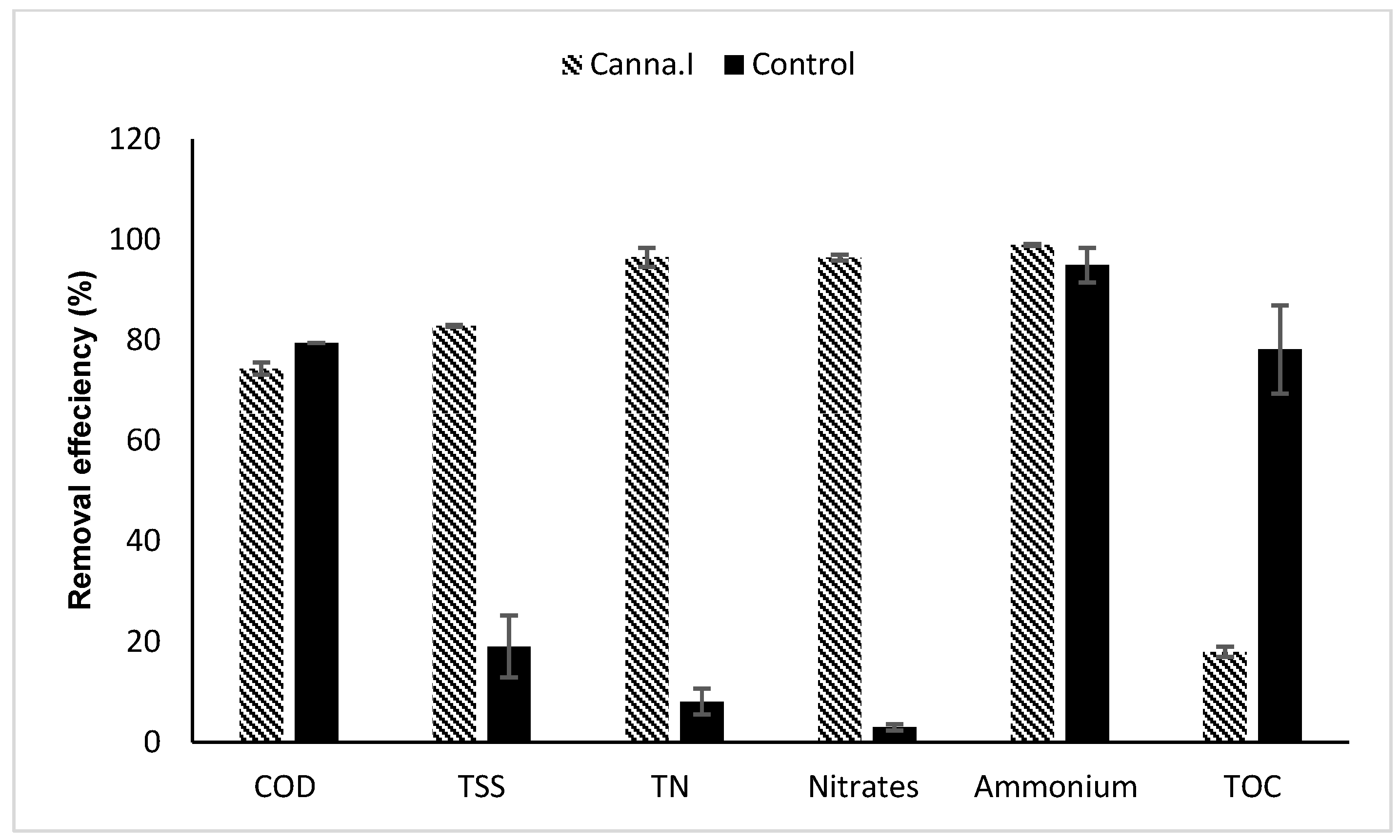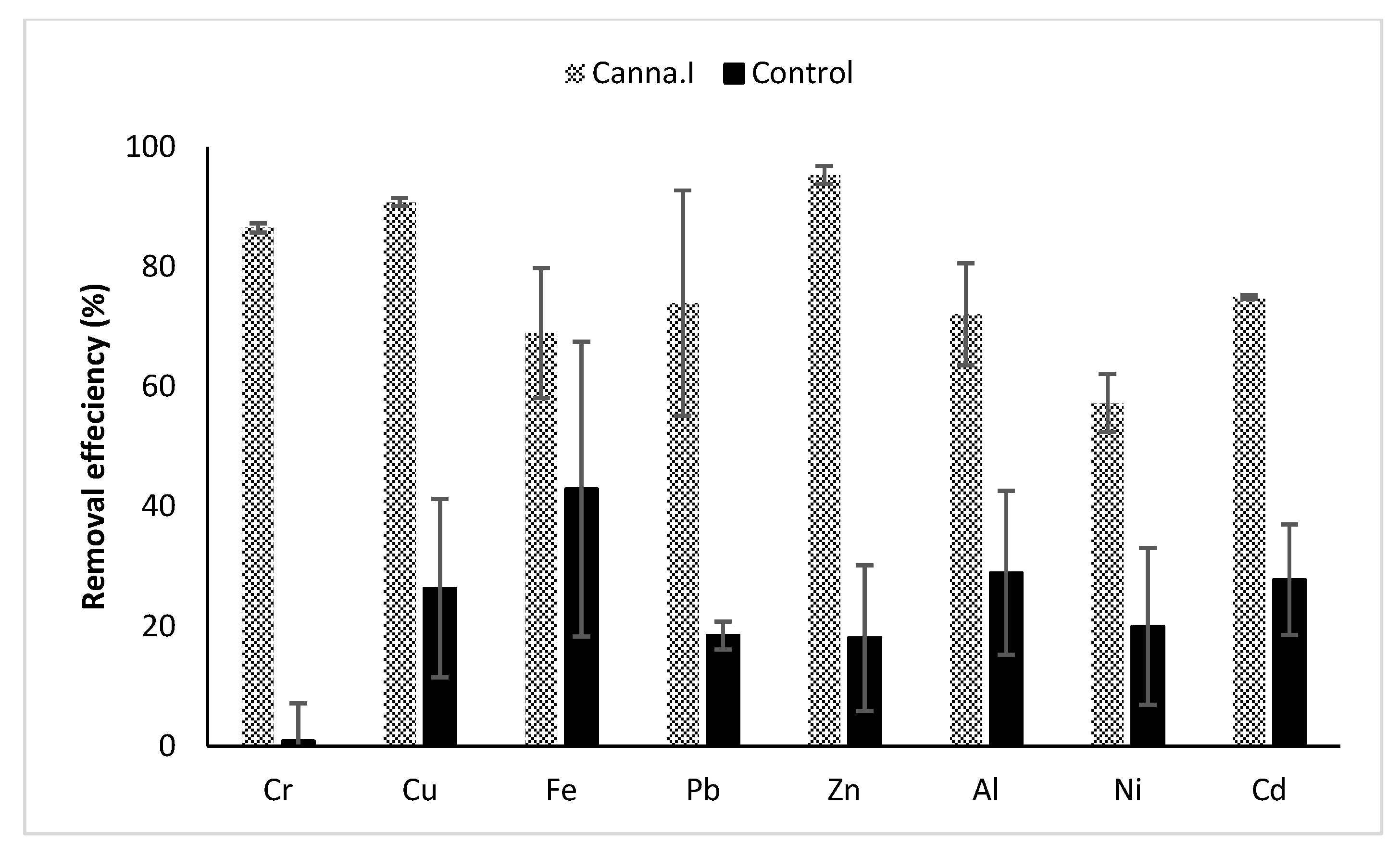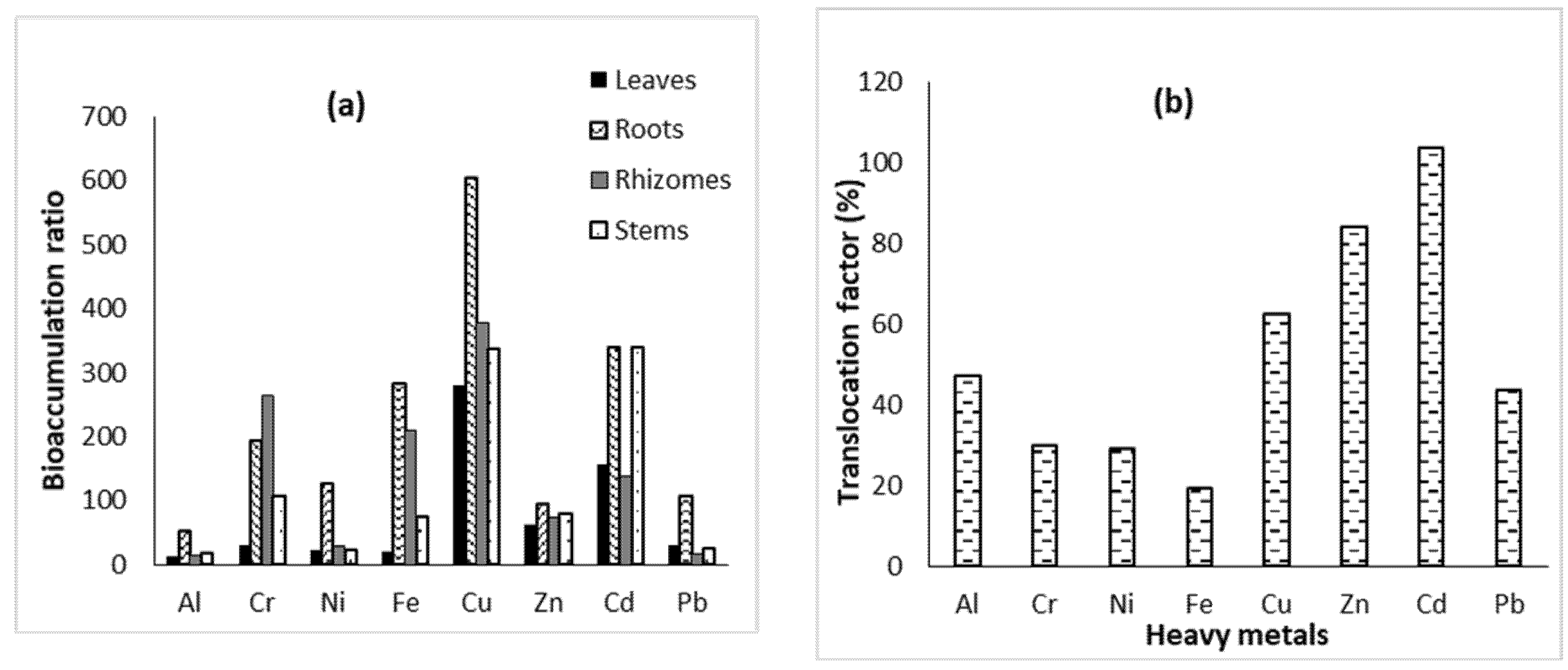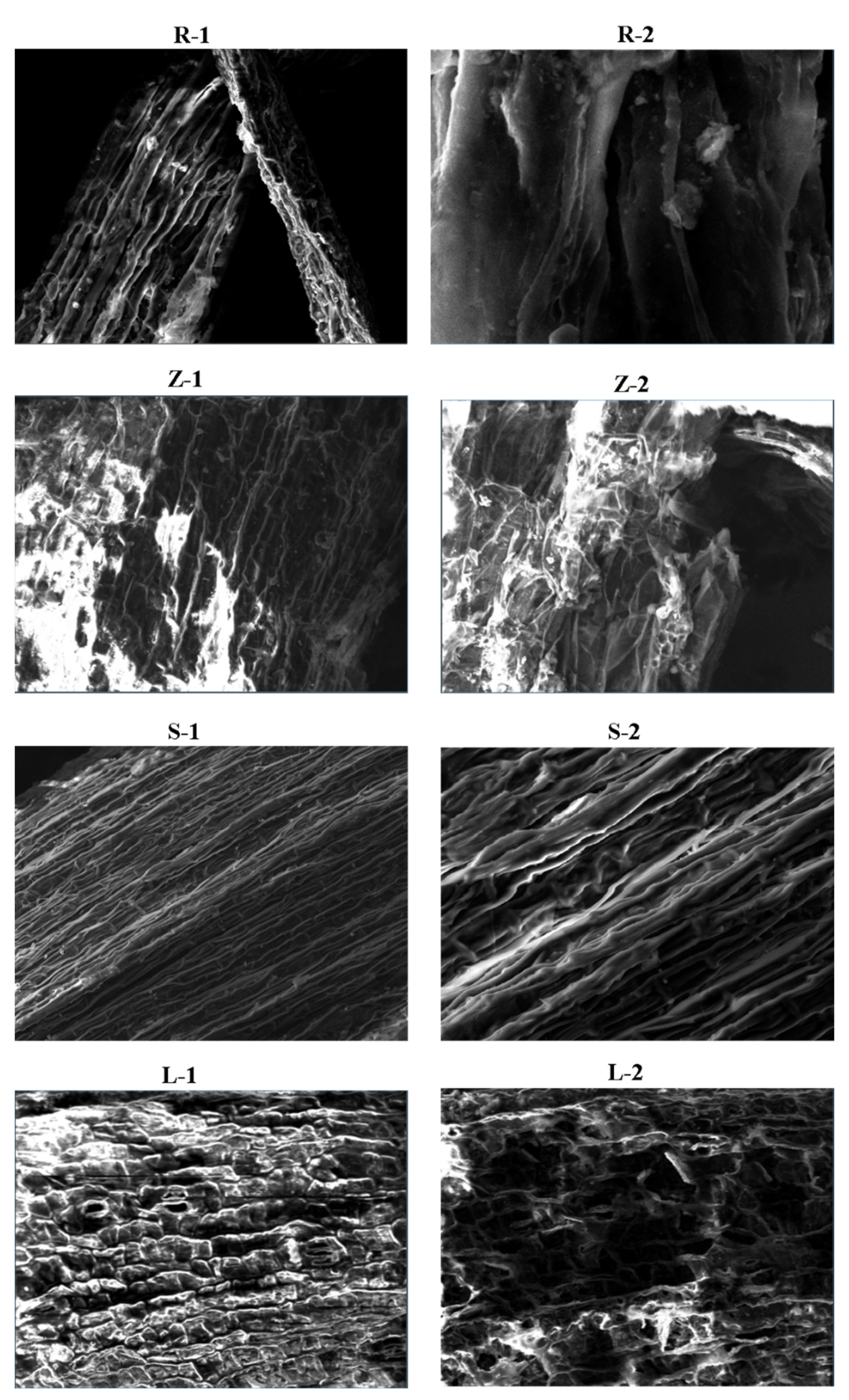Potential of Canna indica in Vertical Flow Constructed Wetlands for Heavy Metals and Nitrogen Removal from Algiers Refinery Wastewater
Abstract
:1. Introduction
2. Materials and Methods
2.1. Experimental Setup
2.2. Sampling and Analysis
2.3. Calculations
3. Results and Discussion
3.1. Treatment Performance of Canna indica CWs
3.2. Heavy Metals Removal
3.3. Concentration of HMs in Canna indica Tissues
3.4. Plant Potential for Bioaccumulation and Translocation of Metals
3.5. SEM-EDX Results
4. Conclusions
Author Contributions
Funding
Institutional Review Board Statement
Informed Consent Statement
Data Availability Statement
Acknowledgments
Conflicts of Interest
References
- Ashar, A.; Naeem, N.; Afshan, N.; Mohsin, M.; Bhutta, Z.A. Remediation of Metal Pollutants in the Environment. In Advanced Oxidation Processes for Wastewater Treatment; CRC Press: Boca Raton, FL, USA, 2022; pp. 223–234. [Google Scholar]
- Noor, S.; Ashar, A.; Taj, M.B.; Bhutta, Z.A. Advanced Oxidation Processes for Remediation of Persistent Organic Pollutants. In Advanced Oxidation Processes for Wastewater Treatment; CRC Press: Boca Raton, FL, USA, 2022; pp. 203–212. [Google Scholar]
- Sharma, P.; Singh, S.P. Pollutants Characterization and Toxicity Assessment of Pulp and Paper Industry Sludge for Safe Environmental Disposal. In Emerging Treatment Technologies for Waste Management; Haq, I., Kalamdhad, A.S., Eds.; Springer: Singapore, 2021; pp. 207–223. [Google Scholar]
- Ho, Y.; Show, K.; Guo, X.; Norli, I.; Alkarkhi, F.; Morad, N. Industrial Discharge and Their Effect to the Environment; InTech Open: Rijeka, Croatia, 2012. [Google Scholar] [CrossRef] [Green Version]
- Rahi, M.N.; Jaeel, A.J.; Abbas, A.J. Treatment of petroleum refinery effluents and wastewater in Iraq: A mini review. IOP Conf. Ser. Mater. Sci. Eng. 2021, 1058, 012072. [Google Scholar] [CrossRef]
- Ghezali, K.; Tahar, N.B.; Otmanine, G.; Guettaf, N. Environmental Assessment and Compliance of Wastewater from Arzew Oil Refinery for Future Development and Reuse. J. Environ. Treat. Tech. 2021, 10, 18–23. [Google Scholar]
- Li, J.; Lin, F.; Li, K.; Zheng, F.; Yan, B.; Che, L.; Tian, W.; Chen, G.; Yoshikawa, K. A critical review on energy recovery and non-hazardous disposal of oily sludge from petroleum industry by pyrolysis. J. Hazard. Mater. 2020, 406, 124706. [Google Scholar] [CrossRef] [PubMed]
- Ahmed, S.; Mofijur, M.; Nuzhat, S.; Chowdhury, A.T.; Rafa, N.; Uddin, A.; Inayat, A.; Mahlia, T.; Ong, H.C.; Chia, W.Y.; et al. Recent developments in physical, biological, chemical, and hybrid treatment techniques for removing emerging contaminants from wastewater. J. Hazard. Mater. 2021, 416, 125912. [Google Scholar] [CrossRef]
- Calheiros, C.S.; Rangel, A.O.; Castro, P.M. Treatment of industrial wastewater with two-stage constructed wetlands planted with Typha latifolia and Phragmites australis. Bioresour. Technol. 2009, 100, 3205–3213. [Google Scholar] [CrossRef]
- Skrzypiec, K.; Gajewska, M.H. The use of constructed wetlands for the treatment of industrial wastewater. J. Water Land Dev. 2017, 34, 233–240. [Google Scholar] [CrossRef]
- Ayaz, T.; Khan, S.; Khan, A.Z.; Lei, M.; Alam, M. Remediation of industrial wastewater using four hydrophyte species: A comparison of individual (pot experiments) and mix plants (constructed wetland). J. Environ. Manag. 2019, 255, 109833. [Google Scholar] [CrossRef]
- Khan, S.; Ahmad, I.; Shah, M.T.; Rehman, S.; Khaliq, A. Use of constructed wetland for the removal of heavy metals from industrial wastewater. J. Environ. Manag. 2009, 90, 3451–3457. [Google Scholar] [CrossRef]
- Rezania, S.; Taib, S.M.; Din, M.F.M.; Dahalan, F.A.; Kamyab, H. Comprehensive review on phytotechnology: Heavy metals removal by diverse aquatic plants species from wastewater. J. Hazard. Mater. 2016, 318, 587–599. [Google Scholar] [CrossRef]
- Tao, Z.; Jing, Z.; Tao, M.; Luo, H.; Wang, Y. Advanced treatment of sewage plant effluent by horizontal subsurface flow constructed wetlands: Effect of coupling with cellulosic carbon sources. Desalination Water Treat. 2020, 189, 53–65. [Google Scholar] [CrossRef]
- Stefanakis, A.I. The Role of Constructed Wetlands as Green Infrastructure for Sustainable Urban Water Management. Sustainability 2019, 11, 6981. [Google Scholar] [CrossRef] [Green Version]
- Avellán, T.; Gremillion, P. Constructed wetlands for resource recovery in developing countries. Renew. Sustain. Energy Rev. 2018, 99, 42–57. [Google Scholar] [CrossRef]
- Aslam, M.M.; Malik, M.; Baig, M.; Qazi, I.; Iqbal, J. Treatment performances of compost-based and gravel-based vertical flow wetlands operated identically for refinery wastewater treatment in Pakistan. Ecol. Eng. 2007, 30, 34–42. [Google Scholar] [CrossRef]
- Mustapha, H.I.; van Bruggen, J.; Lens, P.N.L. Vertical subsurface flow constructed wetlands for polishing secondary Kaduna refinery wastewater in Nigeria. Ecol. Eng. 2015, 84, 588–595. [Google Scholar] [CrossRef]
- Vymazal, J. Constructed wetlands for treatment of industrial wastewaters: A review. Ecol. Eng. 2014, 73, 724–751. [Google Scholar] [CrossRef]
- Varma, M.; Gupta, A.K.; Ghosal, P.S.; Majumder, A. A review on performance of constructed wetlands in tropical and cold climate: Insights of mechanism, role of influencing factors, and system modification in low temperature. Sci. Total Environ. 2021, 755, 142540. [Google Scholar] [CrossRef]
- Yadav, A.; Chazarenc, F.; Mutnuri, S. Development of the “French system” vertical flow constructed wetland to treat raw domestic wastewater in India. Ecol. Eng. 2018, 113, 88–93. [Google Scholar] [CrossRef]
- Vymazal, J.; Zhao, Y.; Mander, Ü. Recent research challenges in constructed wetlands for wastewater treatment: A review. Ecol. Eng. 2021, 169, 106318. [Google Scholar] [CrossRef]
- Marchand, L.; Mench, M.; Jacob, D.; Otte, M. Metal and metalloid removal in constructed wetlands, with emphasis on the importance of plants and standardized measurements: A review. Environ. Pollut. 2010, 158, 3447–3461. [Google Scholar] [CrossRef]
- Sandoval-Herazo, L.C.; Alvarado-Lassman, A.; Marín-Muñiz, J.L.; Méndez-Contreras, J.M.; Zamora-Castro, S.A. Effects of the Use of Ornamental Plants and Different Substrates in the Removal of Wastewater Pollutants through Microcosms of Constructed Wetlands. Sustainability 2018, 10, 1594. [Google Scholar] [CrossRef] [Green Version]
- Wu, H.; Zhang, J.; Ngo, H.H.; Guo, W.; Hu, Z.; Liang, S.; Fan, J.; Liu, H. A review on the sustainability of constructed wetlands for wastewater treatment: Design and operation. Bioresour. Technol. 2014, 175, 594–601. [Google Scholar] [CrossRef] [PubMed]
- Lima, M.X.; Carvalho, K.Q.; Passig, F.H.; Borges, A.C.; Filippe, T.C.; Azevedo, J.C.R.; Nagalli, A. Performance of different substrates in constructed wetlands planted with E. crassipes treating low-strength sewage under subtropical conditions. Sci. Total Environ. 2018, 630, 1365–1373. [Google Scholar] [CrossRef] [PubMed]
- Ferreira, A.R.; Guedes, P.; Mateus, E.P.; Ribeiro, A.B.; Couto, N. Comparative assessment of LECA and Spartina maritima to remove emerging organic contaminants from wastewater. Environ. Sci. Pollut. Res. 2017, 24, 7208–7215. [Google Scholar] [CrossRef] [PubMed]
- Kumari, M.; Tripathi, B. Efficiency of Phragmites australis and Typha latifolia for heavy metal removal from wastewater. Ecotoxicol. Environ. Saf. 2015, 112, 80–86. [Google Scholar] [CrossRef]
- Cui, L.; Ouyang, Y.; Lou, Q.; Yang, F.; Chen, Y.; Zhu, W.; Luo, S. Removal of nutrients from wastewater with Canna indica L. under different vertical-flow constructed wetland conditions. Ecol. Eng. 2010, 36, 1083–1088. [Google Scholar] [CrossRef]
- Jamwal, P.; Raj, A.V.; Raveendran, L.; Shirin, S.; Connelly, S.; Yeluripati, J.; Richards, S.; Rao, L.; Helliwell, R.; Tamburini, M. Evaluating the performance of horizontal sub-surface flow constructed wetlands: A case study from southern India. Ecol. Eng. 2021, 162, 106170. [Google Scholar] [CrossRef]
- Yadav, A.K.; Abbassi, R.; Kumar, N.; Satya, S.; Sreekrishnan, T.R.; Mishra, B.K. The removal of heavy metals in wetland microcosms: Effects of bed depth, plant species, and metal mobility. Chem. Eng. J. 2012, 211–212, 501–507. [Google Scholar] [CrossRef]
- Zhang, X.; Wang, T.; Xu, Z.; Zhang, L.; Dai, Y.; Tang, X.; Tao, R.; Li, R.; Yang, Y.; Tai, Y. Effect of heavy metals in mixed domestic-industrial wastewater on performance of recirculating standing hybrid constructed wetlands (RSHCWs) and their removal. Chem. Eng. J. 2020, 379, 122363. [Google Scholar] [CrossRef]
- Pinninti, R.; Kasi, V.; Sallangi, L.K.S.V.P.; Landa, S.R.; Rathinasamy, M.; Sangamreddi, C.; Radha, P.R.D. Performance of Canna Indica based microscale vertical flow constructed wetland under tropical conditions for domestic wastewater treatment. Int. J. Phytoremediat. 2021, 701, 134736. [Google Scholar] [CrossRef]
- Wang, Y.; Cai, Z.; Sheng, S.; Pan, F.; Chen, F.; Fu, J. Comprehensive evaluation of substrate materials for contaminants removal in constructed wetlands. Sci. Total Environ. 2019, 701, 134736. [Google Scholar] [CrossRef]
- Huang, X.; Zhao, F.; Yu, G.; Song, C.; Geng, Z.; Zhuang, P. Removal of Cu, Zn, Pb, and Cr from Yangtze Estuary Using the Phragmites australis Artificial Floating Wetlands. BioMed Res. Int. 2017, 2017, 6201048. [Google Scholar] [CrossRef] [PubMed] [Green Version]
- Jafarinejad, S.; Jiang, S.C. Current technologies and future directions for treating petroleum refineries and petrochemical plants (PRPP) wastewaters. J. Environ. Chem. Eng. 2019, 7, 103326. [Google Scholar] [CrossRef]
- World Bank Group. Environmental, Health, and Safety Guidelines Petroleum Refining; World Bank Group: Washington, DC, USA, 2016. [Google Scholar]
- Demarty, M.; Prairie, Y.T. In situ dissolved organic carbon (DOC) release by submerged macrophyte–epiphyte communities in southern Quebec lakes. Can. J. Fish. Aquat. Sci. 2009, 66, 1522–1531. [Google Scholar] [CrossRef]
- Mustapha, H.I.; Van Bruggen, H.J.J.A.; Lens, P.N.L. Vertical subsurface flow constructed wetlands for the removal of petroleum contaminants from secondary refinery effluent at the Kaduna refining plant (Kaduna, Nigeria). Environ. Sci. Pollut. Res. 2018, 25, 30451–30462. [Google Scholar] [CrossRef] [PubMed]
- Yang, Q.; Chen, Z.-H.; Zhao, J.-G.; Gu, B.-H. Contaminant Removal of Domestic Wastewater by Constructed Wetlands: Effects of Plant Species. J. Integr. Plant Biol. 2007, 49, 437–446. [Google Scholar] [CrossRef]
- Olawale, O.; Raphael, D.O.; Akinbile, C.O.; Ishuwa, K. Comparison of heavy metal and nutrients removal in Canna indica and Oryza sativa L. based constructed wetlands for piggery effluent treatment in north-central Nigeria. Int. J. Phytoremediat. 2021, 23, 1382–1390. [Google Scholar] [CrossRef] [PubMed]
- Mustapha, H.; Van Bruggen, J.J.A.; Lens, P.N.L. Fate of heavy metals in vertical subsurface flow constructed wetlands treating secondary treated petroleum refinery wastewater in Kaduna, Nigeria. Int. J. Phytoremediat. 2018, 20, 44–53. [Google Scholar] [CrossRef]
- Terzakis, S.; Fountoulakis, M.; Georgaki, I.; Albantakis, D.; Sabathianakis, I.; Karathanasis, A.; Kalogerakis, N.; Manios, T. Constructed wetlands treating highway runoff in the central Mediterranean region. Chemosphere 2008, 72, 141–149. [Google Scholar] [CrossRef]
- Deng, H.; Ye, Z.; Wong, M. Accumulation of lead, zinc, copper and cadmium by 12 wetland plant species thriving in metal-contaminated sites in China. Environ. Pollut. 2004, 132, 29–40. [Google Scholar] [CrossRef]
- Kinraide, T.B.; Yermiyahu, U. A scale of metal ion binding strengths correlating with ionic charge, Pauling electronegativity, toxicity, and other physiological effects. J. Inorg. Biochem. 2007, 101, 1201–1213. [Google Scholar] [CrossRef]
- Vymazal, J.; Březinová, T. Accumulation of heavy metals in aboveground biomass of Phragmites australis in horizontal flow constructed wetlands for wastewater treatment: A review. Chem. Eng. J. 2016, 290, 232–242. [Google Scholar] [CrossRef]
- Hernández-Pérez, C.; Martínez-Sánchez, M.J.; García-Lorenzo, M.L.; Bech, J.; Pérez-Sirvent, C. Phytoremediation of potentially toxic elements using constructed wetlands in coastal areas with a mining influence. Environ. Geochem. Health 2021, 43, 1385–1400. [Google Scholar] [CrossRef] [PubMed]
- Clemens, S.; Palmgren, M.; Kraemer, U. A long way ahead: Understanding and engineering plant metal accumulation. Trends Plant Sci. 2002, 7, 309–315. [Google Scholar] [CrossRef]
- Dindas, J.; Scherzer, S.; Roelfsema, M.R.G.; von Meyer, K.; Müller, H.M.; Al-Rasheid, K.A.S.; Palme, K.; Dietrich, P.; Becker, D.; Bennet, M.J.; et al. AUX1-mediated root hair auxin influx governs SCFTIR1/AFB-type Ca2+ signaling. Nat. Commun. 2018, 9, 1174. [Google Scholar] [CrossRef]





| Parameter | Influent | Canna VFCWs Effluent | Control | WBG * |
|---|---|---|---|---|
| pH | 7.3 ± 0.27 | 6.68 ± 0.07 | 6.79 ± 0.2 | 6.0–9.0 |
| Turbidity (NTU) | 52.26 ± 28 | 5.47 ± 1.32 | 8.56 ± 3.3 | 30 |
| COD (mg/L) | 330 ± 4.24 | 85.8 ± 0.21 | 68.5 ± 0.42 | 125 |
| TSS (mg/L) | 253.3 ± 0.7 | 39.9 ± 0.42 | 173.3 ± 0.7 | 25 |
| TOC (mg/L) | 391 ± 6.36 | 321 ± 4.94 | 83.55 ± 2.65 | / |
| TP (mg/L) | 0.98 ± 0.4 | 1.5 ± 0.7 | 0.88 ± 0.4 | 2 |
| TN (mg/L) | 18.8 ± 0.14 | 0.68 ± 0.02 | 17.5 ± 0.28 | 10 |
| Nitrates (mg/L) | 7.28 ± 0.04 | 0.28 ± 0.01 | 7.04 ± 0.05 | / |
| Ammonium (mg/L) | 9.5 ± 0.14 | 0.08 ± 0.01 | 0.472 ± 0.01 | / |
| Nitrite (mg/L) | 1.18 ± 0.72 | 0.0015 ± 0.001 | 1.1 ± 0.17 | / |
| Chrome total (mg/L) | 2.33 ± 0.03 | 0.314 ± 0.004 | 2.27 ± 0.05 | 0.5 |
| Copper (mg/L) | 0.86 ± 0.03 | 0.079 ± 0.003 | 0.59 ± 0.05 | 0.5 |
| Iron (mg/L) | 2.28 ± 0.06 | 0.8 ± 0.08 | 1.3 ± 0.03 | 3 |
| Lead (mg/L) | 2.06 ± 0.03 | 0.48 ± 0.05 | 1.56 ± 0.11 | 0.1 |
| Zinc (mg/L) | 7.56 ± 0.09 | 0.26 ± 0.07 | 6.27 ± 0.02 | / |
| Aluminum (mg/L) | 1.92 ± 0.03 | 0.53 ± 0.01 | 1.33 ± 0.05 | / |
| Nickel (mg/L) | 1.03 ± 0.05 | 0.46 ± 0.007 | 1 ± 0.08 | 0.5 |
| Cadmium (mg/L) | 0.031 ± 0.003 | 0.002 ± 0.005 | 0.021 ± 0.003 | / |
| Element | Concentrations [mg/kg] | |||
|---|---|---|---|---|
| Roots | Rhizomes | Stems | Leaves | |
| Al | 102 | 29 | 36 | 26 |
| Cr | 450 | 615 | 250 | 70 |
| Ni | 131 | 29 | 23 | 24 |
| Fe | 645 | 480 | 170 | 46.5 |
| Cu | 520 | 325 | 290 | 240 |
| Zn | 710 | 565 | 600 | 475 |
| Cd | 10.5 | 4.3 | 10.5 | 4.8 |
| Pb | 222 | 36 | 51.5 | 61.5 |
| Element | R-a | R-b | Z-a | Z-b |
|---|---|---|---|---|
| Aluminum | 0.28 | 0.22 | 0.01 | 0.01 |
| Arsenic | 0.01 | 0.01 | 0.01 | 0.01 |
| Cadmium | 0.49 | 0.01 | 0.05 | 0.08 |
| Calcium | 2.09 | 4.02 | 0.75 | 1.23 |
| Carbon | 58.47 | 53.14 | 56.09 | 58.12 |
| Chlorine | 1.76 | 1.41 | 0.95 | 2.03 |
| Chromium | 0.02 | 0.22 | 0.06 | 0.03 |
| Cobalt | nd | nd | 0.01 | 0.22 |
| Cooper | 0.12 | 0.4 | 0.12 | 0.07 |
| Fluorine | nd | nd | 0.38 | nd |
| Iron | 1.94 | 1.75 | 0.05 | 0.31 |
| Lead | 0.01 | 0.27 | 0.01 | 0.01 |
| Magnesium | 1.63 | 0.73 | 2.97 | 0.78 |
| Mercury | nd | 0.2 | 0.01 | 0.01 |
| Nickel | 0.04 | 0.17 | 0.07 | 0.04 |
| Nitrogen | 5.76 | 6.89 | nd | 3.66 |
| Oxygen | 22.36 | 26.39 | 29.74 | 28.49 |
| Phosphorus | 0.2 | 0.58 | 0.15 | 0.16 |
| Potassium | 0.46 | 0.33 | 0.76 | 0.33 |
| Silicon | 0.53 | 0.5 | 0.17 | 0.15 |
| Sodium | 3.47 | 2.16 | 6.59 | 4.08 |
| Sulphur | 0.35 | 0.25 | 1.02 | 0.17 |
| Vanadium | 0.01 | 0.14 | 0.03 | 0.01 |
| Zinc | 0.01 | 0.22 | 0.01 | 0.01 |
| Element | S-a | S-b | L-a | L-b |
|---|---|---|---|---|
| Aluminum | 0.28 | 0.23 | 0.11 | 0.08 |
| Arsenic | 0.45 | 0.12 | 0.01 | 0.01 |
| Cadmium | 0.01 | 0.01 | 0.01 | 0.01 |
| Calcium | nd | 0.37 | nd | nd |
| Carbon | 64.8 | 65.14 | 68.33 | 66.92 |
| Chlorine | 2.43 | 2.74 | 0.76 | 0.58 |
| Chromium | 0.31 | 0.21 | 0.01 | 0.01 |
| Cobalt | 0.32 | 0.24 | 0.05 | 0.14 |
| Copper | 0.56 | 0.28 | 0.01 | 0.01 |
| Fluorine | 0.12 | 0.33 | 0.89 | 1.01 |
| Iron | 0.43 | 0.28 | 0.01 | 0.01 |
| Lead | 0.01 | 0.01 | 0.01 | 0.01 |
| Magnesium | 0.01 | 0.01 | 0.18 | 0.15 |
| Mercury | 0.11 | 0.01 | 0.01 | 0.01 |
| Nickel | nd | 0.17 | 0.01 | 0.01 |
| Nitrogen | 0.27 | 3.67 | 4.55 | 4.56 |
| Oxygen | 24.08 | 22.88 | 22.21 | 24.16 |
| Phosphorus | 0.01 | 0.01 | 0.13 | 0.06 |
| Potassium | 0.77 | 0.98 | 1.16 | 0.82 |
| Silicon | 0.01 | 0.01 | 0.11 | 0.07 |
| Sodium | 1.05 | 1.92 | 1.43 | 1.36 |
| Sulphur | 0.01 | 0.01 | 0.02 | 0.01 |
| Vanadium | 0.15 | 0.13 | 0.01 | 0.01 |
| Zinc | 0.6 | 0.23 | 0.01 | 0.01 |
Publisher’s Note: MDPI stays neutral with regard to jurisdictional claims in published maps and institutional affiliations. |
© 2022 by the authors. Licensee MDPI, Basel, Switzerland. This article is an open access article distributed under the terms and conditions of the Creative Commons Attribution (CC BY) license (https://creativecommons.org/licenses/by/4.0/).
Share and Cite
Ghezali, K.; Bentahar, N.; Barsan, N.; Nedeff, V.; Moșneguțu, E. Potential of Canna indica in Vertical Flow Constructed Wetlands for Heavy Metals and Nitrogen Removal from Algiers Refinery Wastewater. Sustainability 2022, 14, 4394. https://doi.org/10.3390/su14084394
Ghezali K, Bentahar N, Barsan N, Nedeff V, Moșneguțu E. Potential of Canna indica in Vertical Flow Constructed Wetlands for Heavy Metals and Nitrogen Removal from Algiers Refinery Wastewater. Sustainability. 2022; 14(8):4394. https://doi.org/10.3390/su14084394
Chicago/Turabian StyleGhezali, Katia, Nourredine Bentahar, Narcis Barsan, Valentin Nedeff, and Emilian Moșneguțu. 2022. "Potential of Canna indica in Vertical Flow Constructed Wetlands for Heavy Metals and Nitrogen Removal from Algiers Refinery Wastewater" Sustainability 14, no. 8: 4394. https://doi.org/10.3390/su14084394
APA StyleGhezali, K., Bentahar, N., Barsan, N., Nedeff, V., & Moșneguțu, E. (2022). Potential of Canna indica in Vertical Flow Constructed Wetlands for Heavy Metals and Nitrogen Removal from Algiers Refinery Wastewater. Sustainability, 14(8), 4394. https://doi.org/10.3390/su14084394








